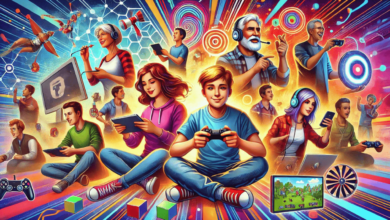The GLNG Game Acronym What Gamers Need to Know

It should be noted that gaming industry, in addition to being filled with creative and fascinating ideas, is full of terms, jargons and acronyms that new-comers may find rather confusing even when they are in their early stages of exposures. There is one relatively new game acronym which has been attracting considerable attention recently: GLNG. Regardless of the level of the involvement in the gaming culture this acronym and what is behind it can only be beneficial to anyone who considers himself a gamer. This is a comprehensive guide on what the GLNG game acronym means, its relevance in the gaming industry and why every gamer should know about it.
What is the GLNG Game Acronym?
First of all, let us better understand what game acronym consists of. This abbreviation is somewhat familiar to the members of the gaming community and they do employ it frequently, however it’s meaning is not quite clear for everyone. According to the author, GLNG denotes Game Levels, Narrative and Goals This is because these are three major components that are in almost all actual video games.
- Game Levels (GL) – The structural layout of a game, which typically includes various stages or levels that players progress through.
- Narrative (N) – The storyline or plot that provides context and engagement for players.
- Goals (G) – The objectives players must achieve to complete levels or progress in the game.
Learning this acronym is useful in identifying the basic elements of games that can be useful while focusing on the strategies of the games or while communicating with other players.
Why the GLNG Game Acronym Matters
GLNG acronym used in the game is more than just an abbreviation of the letters, those are the fundamentals which outline most of the existing games at the moment. No matter what kind of the genre it is, whether it is a role playing game (RPG), first person shooter game (FPS) or even puzzle game, the GLNG structure is applicable to almost all of them. Here’s why it matters:
- Game Design Insights: Understanding the GLNG game acronym helps players appreciate the intricate work behind designing a game. Developers use levels, narratives, and goals to create engaging, immersive worlds.
- Better Gaming Strategies: By focusing on these elements, gamers can refine their strategies. Recognizing when a game is level-heavy versus narrative-driven can change how one approaches gameplay.
- Improved Communication: When talking to other gamers or participating in online forums, using the game acronym shows you are well-versed in gaming lingo.
The Evolution of the GLNG Game Acronym
As is the case with most gaming terms the game acronym has not been static but has been changed with time. The games that were developed during the 1980s and the 1990s were mainly designed according to the levels and goals of the game. With improvements in the gaming technology as well as the development of the techniques of storytelling, it was realized that depth of the plot was equally valuable as gameplay. Therefore, today’s games are narrative rich and complex and the acronym GLNG has become popular to combine these three basic components.
Early Games and the Focus on Levels and Goals
Previously in the classic arcade games such as Pac-Man and the early structure of Donkey Kong, the GLNG structure existed, though simplistic. The degree of emphasis was on levels and goals and goals only. With each level there were new problems that the player had to face and it was possible to get a high score or complete the game.
The Rise of Narrative-Driven Games
While games such as the Mario Bros and Tetris did not have any preeminence, it was in the late 1980s when stories began to emerge with the appearance of titles such as The Legend of Zelda, Final Fantasy and so on. The attrition of continuity is that Gamers were no longer just playing to get through level but they have a story to go along with the games. Transformation of the game acronym GLNG helped to adapt it as the narrative joined the list of the game components along with the levels and the goals.
GLNG Game Acronym: How Developers Use It
To game developers, game acronym becomes a model of sorts. When creating a new game, developers use this framework to ensure they are offering players a balanced experience that includes all three elements: interacting levels, interesting stories and focused objectives.
Designing Game Levels (GL)
Creating levels is an art in itself. Game levels must challenge players but not overwhelm them. Levels should gradually increase in difficulty, offering a sense of progression. Using the GLNG game acronym helps developers focus on this progression to keep players engaged.
Crafting a Compelling Narrative (N)
The narrative is the heart of many modern games. Developers use storytelling techniques to immerse players in the game world. Whether it’s a simple story in a puzzle game or a complex plot in an RPG, the narrative guides players, giving them a reason to continue.
Setting Achievable Goals (G)
Clear goals provide players with motivation. Developers design these goals to be attainable but challenging, ensuring that players feel a sense of accomplishment when they complete them. The game acronym emphasizes the importance of well-defined goals in keeping players engaged.
How Gamers Can Use the GLNG Game Acronym
Now that you understand what the game acronym stands for, let’s talk about how you, as a gamer, can use this knowledge to improve your gameplay and experience.
1. Mastering Game Levels (GL)
Understanding the structure of game levels can help you develop better strategies for progression. In games like Super Mario Bros., where each level introduces new obstacles, understanding the game’s level design can give you the upper hand.
2. Immersing Yourself in the Narrative (N)
In games like The Witcher 3: Wild Hunt, the narrative is key to the experience. By focusing on the story, you can deepen your connection to the characters and the world, enhancing your overall enjoyment. Recognizing the importance of narrative through the GLNG game acronym can also help you choose games that align with your interests.
3. Setting Personal Goals (G)
While games come with built-in goals, players can set their own goals to enhance their gaming experience. For example, in open-world games like Red Dead Redemption 2, you might set personal objectives, like exploring a specific area or mastering a particular skill. The game acronym reminds you that goals are an essential part of the gaming experience.
GLNG Game Acronym in Popular Titles
The game acronym can be seen in action in many popular titles. Let’s look at a few examples of games where this acronym plays a crucial role.
1. The Last of Us (N for Narrative)
In The Last of Us, it is possible to state that the story represents one of the key mechanics. The consumers develop an attachment to the characters as well as the plot leading the game to be much more than levels. This is what is in the centre of using the GLNG game acronym and showing how a great story is crucial.
2. Portal (GL for Game Levels)
Puzzles and their creation form the basis of Portal, but its main focus is on the design of the space it presents. The type of challenges elevated with each level is logical, and it is another way through which the player’s ability to solve the puzzles is tested. The explosion of Game Level Notation in the game acronym emphasises how various forms of games can highlight various aspects of the game.
3. Fortnite (G for Goals)
From the case of Fortnite goals are an important part of the game. Regardless it is in a quest to be the only survivor or accomplishing weekly objectives, the game is framed using goals. Here, the game acronym shows how goals are useful in engaging the players as shown below.
The Future of the GLNG Game Acronym
This is an important realization since the acronym GLNG game will continue to experience changes as the technology of gaming advances. Advanced technology of video games such as VR and AR may be having different approaches to levels, narratives, and goals within games.
Expanding the GLNG Acronym
Some developers are even considering expanding the acronym to include additional elements, such as:
- A for Audio: Acknowledging the importance of sound design.
- C for Community: Recognizing the role of multiplayer and online communities in modern gaming.
As these elements become more important, the game acronym may evolve to capture the full scope of what makes a great game.
Conclusion
The GLNG game acronym encapsulates the essential components of modern gaming: segments we can found at games including levels, story and objectives. It is certainly enlightening to know this acronym and even improve the experience of games that have been created if one is a gamer or a game developer. It thus goes without saying that knowing what is in store in between such factors, whether for a real casual player or otherwise, could assist one in yarding the probabilities more proficiently within the domain of game. The next time you’re on your game console or playing on your gaming PC, just have in mind the game acronym and appreciate the depth it adds to games.




